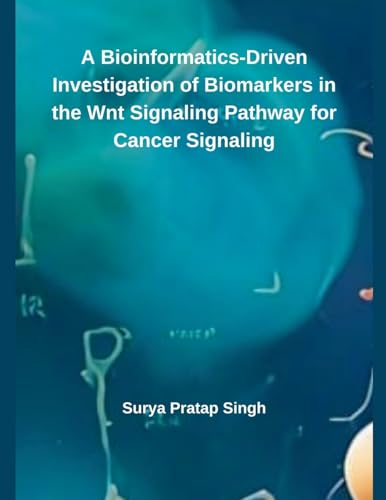A Bioinformatics-Driven Investigation of Biomarkers in the Wnt Signaling Pathway for Cancer Signaling - Brossura

Sinossi
Cell signaling is a way of communication among the living cells and involves the processing of biochemical information to regulate metabolic and cellular activities of the organism. The process of signaling initiates with a chemical species (i.e. ligands or signaling molecules) and ends with the cellular responses. The signal molecules are recognized by the receptors on the surface of target cells and the message is transferred inside the cell in series of steps, the signal transduction pathway, to produce the desired effects. Many signaling pathways have been studied for their involvement in cellular processes such as differentiation and proliferation. One such pathway is Wnt-signaling pathway which is an ancient and highly conserved among all metazoans; it is known to have roles in regulating life processes such as embryonic development, cell growth and survival, cell differentiation, migration and polarity (Wodarz et al., 1998). The term Wnt is derived from the name of two genes viz. wingless gene of Drosophila which is a segment polarity gene and its vertebrate homolog integrated or int-1 (Komiya and Habas, 2008). The extracellular signaling molecule of this pathway (i.e. ligand) is a glycoprotein known as Wnt, which binds to, and dimerize, two receptors namely LRP6/5 and Fz. The downstream signal is transported to the nucleus and promotes the transcription of Wnt responsive genes which ultimately regulate a wide variety of cellular processes including cell fate determination, motility, polarity, primary axis formation, stem cell renewal and organogenesis. The intracellular
Le informazioni nella sezione "Riassunto" possono far riferimento a edizioni diverse di questo titolo.
Risultati della ricerca per A Bioinformatics-Driven Investigation of Biomarkers...
A Bioinformatics-Driven Investigation of Biomarkers in the Wnt Signaling Pathway for Cancer Signaling
Da: GreatBookPrices, Columbia, MD, U.S.A.
Condizione: New. Codice articolo 48919444-n
Compra nuovo
Spedito in U.S.A.
Quantità: Più di 20 disponibili
A Bioinformatics-Driven Investigation of Biomarkers in the Wnt Signaling Pathway for Cancer Signaling
Da: California Books, Miami, FL, U.S.A.
Condizione: New. Codice articolo I-9798227849342
Compra nuovo
Spedito in U.S.A.
Quantità: Più di 20 disponibili
A Bioinformatics-Driven Investigation of Biomarkers in the Wnt Signaling Pathway for Cancer Signaling
Da: GreatBookPrices, Columbia, MD, U.S.A.
Condizione: As New. Unread book in perfect condition. Codice articolo 48919444
Compra usato
Spedito in U.S.A.
Quantità: Più di 20 disponibili
A Bioinformatics-Driven Investigation of Biomarkers in the Wnt Signaling Pathway for Cancer Signaling
Print on DemandDa: PBShop.store US, Wood Dale, IL, U.S.A.
PAP. Condizione: New. New Book. Shipped from UK. THIS BOOK IS PRINTED ON DEMAND. Established seller since 2000. Codice articolo L0-9798227849342
Compra nuovo
Spedito in U.S.A.
Quantità: Più di 20 disponibili
A Bioinformatics-Driven Investigation of Biomarkers in the Wnt Signaling Pathway for Cancer Signaling
Print on DemandDa: PBShop.store UK, Fairford, GLOS, Regno Unito
PAP. Condizione: New. New Book. Delivered from our UK warehouse in 4 to 14 business days. THIS BOOK IS PRINTED ON DEMAND. Established seller since 2000. Codice articolo L0-9798227849342
Compra nuovo
Spedito da Regno Unito a U.S.A.
Quantità: Più di 20 disponibili
A Bioinformatics-Driven Investigation of Biomarkers in the Wnt Signaling Pathway for Cancer Signaling
Da: Rarewaves USA, OSWEGO, IL, U.S.A.
Paperback. Condizione: New. Codice articolo LU-9798227849342
Compra nuovo
Spedito in U.S.A.
Quantità: Più di 20 disponibili
A Bioinformatics-Driven Investigation of Biomarkers in the Wnt Signaling Pathway for Cancer Signaling
Da: Rarewaves.com USA, London, LONDO, Regno Unito
Paperback. Condizione: New. Codice articolo LU-9798227849342
Compra nuovo
Spedito da Regno Unito a U.S.A.
Quantità: Più di 20 disponibili
A Bioinformatics-Driven Investigation of Biomarkers in the Wnt Signaling Pathway for Cancer Signaling
Da: GreatBookPricesUK, Woodford Green, Regno Unito
Condizione: New. Codice articolo 48919444-n
Compra nuovo
Spedito da Regno Unito a U.S.A.
Quantità: Più di 20 disponibili
A Bioinformatics-Driven Investigation of Biomarkers in the Wnt Signaling Pathway for Cancer Signaling
Da: GreatBookPricesUK, Woodford Green, Regno Unito
Condizione: As New. Unread book in perfect condition. Codice articolo 48919444
Compra usato
Spedito da Regno Unito a U.S.A.
Quantità: Più di 20 disponibili
A Bioinformatics-Driven Investigation of Biomarkers in the Wnt Signaling Pathway for Cancer Signaling
Da: Rarewaves USA United, OSWEGO, IL, U.S.A.
Paperback. Condizione: New. Codice articolo LU-9798227849342
Compra nuovo
Spedito in U.S.A.
Quantità: Più di 20 disponibili
